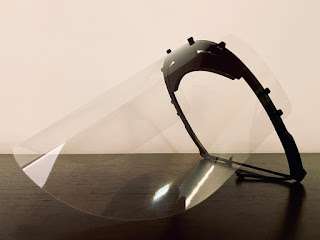Agile and Aligned – deployable multipurpose isolation cells
Centre for Human Habitat
and Alternative Technology – CHHAT has been always active in designing emergent
structures for emergency needs, focused specifically on providing for the
under-represented strata of the Indian society.
This has also earned them
the coveted Buckminster Fuller award for socially responsible design.
With their background in
architecture, engineering and education, Chhat has always been agile and
proactive in offering their expertise whenever the need emerged.
With this medical
emergency and a man-made disaster in the form of COVID-19, the team found themselves
overwhelmed as, although they had designed and prepared for natural disasters, they
had never anticipated a calamity of this form. They were looking at it, trying
to see where designers could fit it, especially young architects who can build
with their own hands.
It required them to
quickly re-configure themselves – all spread across various cities in the
country. They processed all the information and research available on the
pandemic and applied it to their background knowledge and skillset – emerging
with a very appropriate solution for the current needs – deployable isolation
cells for multiple uses.
The need was glaringly apparent – there
were large hospital wards with patients having varying degrees of contagion
that ideally needed isolation but that was not possible with hospital infrastructure. There were police check points to enforce lock-down rules, especially
at city entry points and outside containment zones. The migrants were still
waiting in large numbers at city outskirts. Every situation required isolation cells
– that could contain the spread through air borne particles emanating from
sneezing and coughing.
Thus, Chhat began designing these multipurpose
deployable isolation cells. The design parameters were clear and aligned – they
wanted the design to be simple that could be made anywhere across India with
materials easily available. The unit had to be extremely cost effective and
extremely easy to assemble. At 1500/- a unit of 7’ x 7’ – this booth is truly India
centric.
A team of 6 to 8 people is able to put
together close to 25-30 such units in a day. They are compact when folded up,
hence easy to transport. And once the booths reach location, it requires merely
2 people who can swiftly deploy a cell in under 2 minutes!
The design team is constantly evolving
the design based on feedback – and now the units come with detachable roofs,
for conditions where there is common ventilation in large halls of hospitals
and providing individual fans in not feasible. With simple, straightforward
communication, the team is trying to expand the use of these cells by getting
in touch with relevant decision makers.
The next proposal that the team is working
on, is looking into the future of the post pandemic world.
They are putting together a kit of
essentials that every large public gathering space will require – ranging from
schools, to hospitals to eateries, while adhering to their pre-conditions of
the designs being efficient, cost effective and with locally sourced materials.
They want to make maximum impact by
reaching the large spectrum of the society that struggles for basic resources
and cannot afford high end solutions for hygiene and well-being – but surely
deserve both.
Chhat, therefore is an inspiration for
the young design community – with agile minds and aligned interests.
PROJECT INFO :
Architects: Centre for Human Habitat and
Alternative Technology - CHHAT FOUNDATION
Project Title: Multipurpose Quarantine Cells for
SARS COV-2
Year: 2020
Implemented in: Anand District, Gujarat, India.
Founder: Prof.Nirav Hirpara, Director-Vadodara Design Academy.
Co-Founder : Ar.Sapan Hirpara
Core Team Members: Ar. Anoli Shah (Hyderabad), Ar. Arihant Bajaj
(Indore), Ar. Chetak Mistry (Mehsana), Ar. Durjoy Biswas (Kolkata), Dwij
Hirpara (Anand), Ar. Gazelle Modi (Ahmedabad), Ar. Gunjan Modi (Surat),
Ar. Himalay Goraniya (Porbandar), Ar.Karan Divecha (Vadodara) and Sakshi Pawar
(Goa).
Local Collaborators: Rotary Club of Anand Round Town.
DESIGN SPECIFICATIONS
:
Size: 7x7x7 feet
Materials: Bamboo Frame and High-density
Polypropylene fabric
System Type: Deployable structure.
Building Capacity: 200 Cells each week
Time to assemble: 25 minutes
Time to deploy: < 2 minutes











Ohhh so wonderful. Sapan, Dwij so proud on you. Really wonderful.
ReplyDeletethank you sir ! really means a lot coming from you
DeleteKeep up the innovative and inspiring work Nirav! It was a pleasure to know about this project. A much needed solution in current times. ... Prof JP Singh / Chandigarh.
ReplyDeleteWonderful, simply not only working out a solution to the problem but thinking forward and peeping into the post Corona world.
ReplyDeleteThinkers are future leaders.
Dinesh Patel